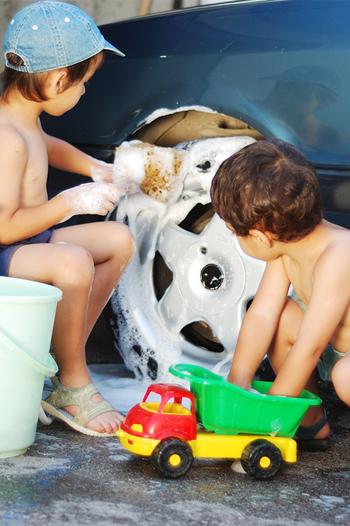Working at the car wash
Duration/age

Is it time to wash your car? Your child can get involved too. All you need is the car, a bucket of soapy water, a sponge, and a towel to dry everyone with after you finish.
Before you start, talk about how you will wash the car. Do you rinse it first with the hose to get the dust and dirt off? What’s next? Is it washing with soapy water and then rinsing? What do you need to wash the windows with? Do you use polish afterwards? Are there parts of the car you don’t wash? Why not? As you go, talk about the names of the different parts of the car. There are doors, windows, a bonnet, a boot, hub caps, a grille - what else can you find?
As you wash the car, explore all the different shapes on parts of the car. The wheels are round, but what about the shapes on the hub caps?
There is usually writing on a car too. Look everywhere as you wash, and don’t forget the tyres. Can you find all the writing on the car? What do you think it says? Why is it there?
Can you see any numbers on the car? Let’s read them out loud.
Materials you will need
- Car
- Bucket
- Water
- Towel
- Hose
- Sponges
- Soap or car wash detergent
Skills this activity improves
Why does this matter?
When children are washing the car they are using big muscles and small muscles. This helps them to develop coordination and control as well as strength.
Planning the steps in the car washing process helps children learn about sequencing - you can’t polish the car before you wash it.
Talking with your child helps to build their vocabulary, in this case about car parts, shapes and numbers.
Finding shapes, letters and numbers on the car helps children recognise them and learn words to name them.
What does this lead to?
Muscle control helps children when they are learning to write and draw. Being able to hold your body steady and being able to use small muscles means that writing is an easier process.
Learning about sequencing helps children become planners and logical thinkers.
A broad vocabulary helps children to express themselves, understand others and will help when they are learning to read.
Being able to recognise shapes, numbers and letters helps children to think mathematically.
Language to use
- Car, wash
- Wheels, bonnet, doors, bumper bar, boot, roof, grille
- Headlights, tail-lights, indicators
- Front, back, side
- Wet, soap, water, suds
- Scrub, rinse, polish, buff
- Writing, numbers, letters
- Circle, square, triangle, diamond
Questions to use
- What do we need to do first?
- Which part of the car will you wash first?
- How high can you reach?
- Can you see your reflection in the car door or in the hub cap?
- How many bits of writing can you find?
- What do you think this shape is? Can you find another shape like this?
Useful tips
- Make sure that your car is in a safe place and that the handbrake is on.
- For safety information, especially about kids and driveways, visit www.parenting.sa.gov.au
- You might also like to take a look at the activities We're off and racing and Building a car.
- Remember to talk to your child in your home language.
More ideas
Do you have anything else that children can wash, like outdoor furniture or windows?
Variation by age
Birth to two year olds
- Build a waterless car wash for your child. Line up some dining chairs to form a tunnel. Hang some long socks or stockings down between the chairs. Your child can then crawl through the car wash. Don’t forget to make the swoosh, swoosh sounds of the car wash.
Three to five year olds
- Take your child through an automated car wash. Being inside the car is a different perspective.
- Make a car wash for your child’s toy cars. It can be as simple as washing toy cars in a tub of water. Another version would be to wash all the ride-on toys and bikes.
- Put together a pretend indoor car wash by hanging streamers of crepe paper from a doorway. You could also make a car out of a big box and drive through the car wash.
Questions to ask
- Can you crawl through the car wash?
- Can you make the same noises as a car?
Questions to ask
- Why aren’t we getting wet?
- How can we clean these cars? How can we dry these cars?
Language to use
- Through, under
- Crawl, slide
- Brrrm
- Swoosh, swoosh
Language to use
- Water, suds, air
- Brushes, rotating, spinning
- Wet, dry, polish
- Scrub, clean
- Drive, engine


